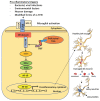Possible Link between SARS-CoV-2 Infection and Parkinson's Disease: The Role of Toll-Like Receptor 4
- PMID: 34281186
- PMCID: PMC8269350
- DOI: 10.3390/ijms22137135
Possible Link between SARS-CoV-2 Infection and Parkinson's Disease: The Role of Toll-Like Receptor 4
Abstract
Parkinson's disease (PD) is the most common neurodegenerative motor disorder characterized by selective degeneration of dopaminergic neurons in the substantia nigra pars compacta (SNpc) of the midbrain, depletion of dopamine (DA), and impaired nigrostriatal pathway. The pathological hallmark of PD includes the aggregation and accumulation α-synuclein (α-SYN). Although the precise mechanisms underlying the pathogenesis of PD are still unknown, the activation of toll-like receptors (TLRs), mainly TLR4 and subsequent neuroinflammatory immune response, seem to play a significant role. Mounting evidence suggests that viral infection can concur with the precipitation of PD or parkinsonism. The recently identified coronavirus named severe acute respiratory syndrome coronavirus 2 (SARS-CoV-2) is the causative agent of ongoing pandemic coronavirus disease 2019 (COVID-19), responsible for 160 million cases that led to the death of more than three million individuals worldwide. Studies have reported that many patients with COVID-19 display several neurological manifestations, including acute cerebrovascular diseases, conscious disturbance, and typical motor and non-motor symptoms accompanying PD. In this review, the neurotropic potential of SARS-CoV-2 and its possible involvement in the pathogenesis of PD are discussed. Specifically, the involvement of the TLR4 signaling pathway in mediating the virus entry, as well as the massive immune and inflammatory response in COVID-19 patients is explored. The binding of SARS-CoV-2 spike (S) protein to TLR4 and the possible interaction between SARS-CoV-2 and α-SYN as contributing factors to neuronal death are also considered.
Keywords: COVID-19; Parkinson’s disease; SARS-CoV-2; neuroinflammation; synuclein; toll-like receptor 4.
Conflict of interest statement
The author declares no conflict of interest.
Figures





Similar articles
-
The effect of SARS-CoV-2 on the development of Parkinson's disease: the role of α-synuclein.Hum Cell. 2024 Jan;37(1):1-8. doi: 10.1007/s13577-023-00988-2. Epub 2023 Sep 21. Hum Cell. 2024. PMID: 37735344 Review.
-
Does COVID-19 Trigger the Risk for the Development of Parkinson's Disease? Therapeutic Potential of Vitamin C.Mol Neurobiol. 2024 Dec;61(12):9945-9960. doi: 10.1007/s12035-023-03756-3. Epub 2023 Nov 14. Mol Neurobiol. 2024. PMID: 37957424 Review.
-
Post-COVID-19 Parkinsonism and Parkinson's Disease Pathogenesis: The Exosomal Cargo Hypothesis.Int J Mol Sci. 2022 Aug 28;23(17):9739. doi: 10.3390/ijms23179739. Int J Mol Sci. 2022. PMID: 36077138 Free PMC article. Review.
-
Toll-like Receptor 4 Is Upregulated in Parkinson's Disease Patients and Co-Localizes with pSer129αSyn: A Possible Link with the Pathology.Cells. 2023 May 11;12(10):1368. doi: 10.3390/cells12101368. Cells. 2023. PMID: 37408202 Free PMC article.
-
Dopamine Transmission Imbalance in Neuroinflammation: Perspectives on Long-Term COVID-19.Int J Mol Sci. 2023 Mar 15;24(6):5618. doi: 10.3390/ijms24065618. Int J Mol Sci. 2023. PMID: 36982693 Free PMC article. Review.
Cited by
-
Implications of the Immune Polymorphisms of the Host and the Genetic Variability of SARS-CoV-2 in the Development of COVID-19.Viruses. 2022 Jan 6;14(1):94. doi: 10.3390/v14010094. Viruses. 2022. PMID: 35062298 Free PMC article. Review.
-
SARS-CoV-2 Attacks in the Brain: Focus on the Sialome.Cells. 2022 Apr 26;11(9):1458. doi: 10.3390/cells11091458. Cells. 2022. PMID: 35563764 Free PMC article. Review.
-
Oleuropein as a Potent Compound against Neurological Complications Linked with COVID-19: A Computational Biology Approach.Entropy (Basel). 2022 Jun 26;24(7):881. doi: 10.3390/e24070881. Entropy (Basel). 2022. PMID: 35885104 Free PMC article.
-
TLR2/4 are novel activating receptors for SARS-CoV-2 spike protein on NK cells.Front Immunol. 2024 May 31;15:1368946. doi: 10.3389/fimmu.2024.1368946. eCollection 2024. Front Immunol. 2024. PMID: 38881905 Free PMC article.
-
Aggravating mechanisms from COVID-19.Virol J. 2024 Sep 27;21(1):228. doi: 10.1186/s12985-024-02506-8. Virol J. 2024. PMID: 39334442 Free PMC article. Review.
References
Publication types
MeSH terms
Substances
LinkOut - more resources
Full Text Sources
Medical
Miscellaneous

